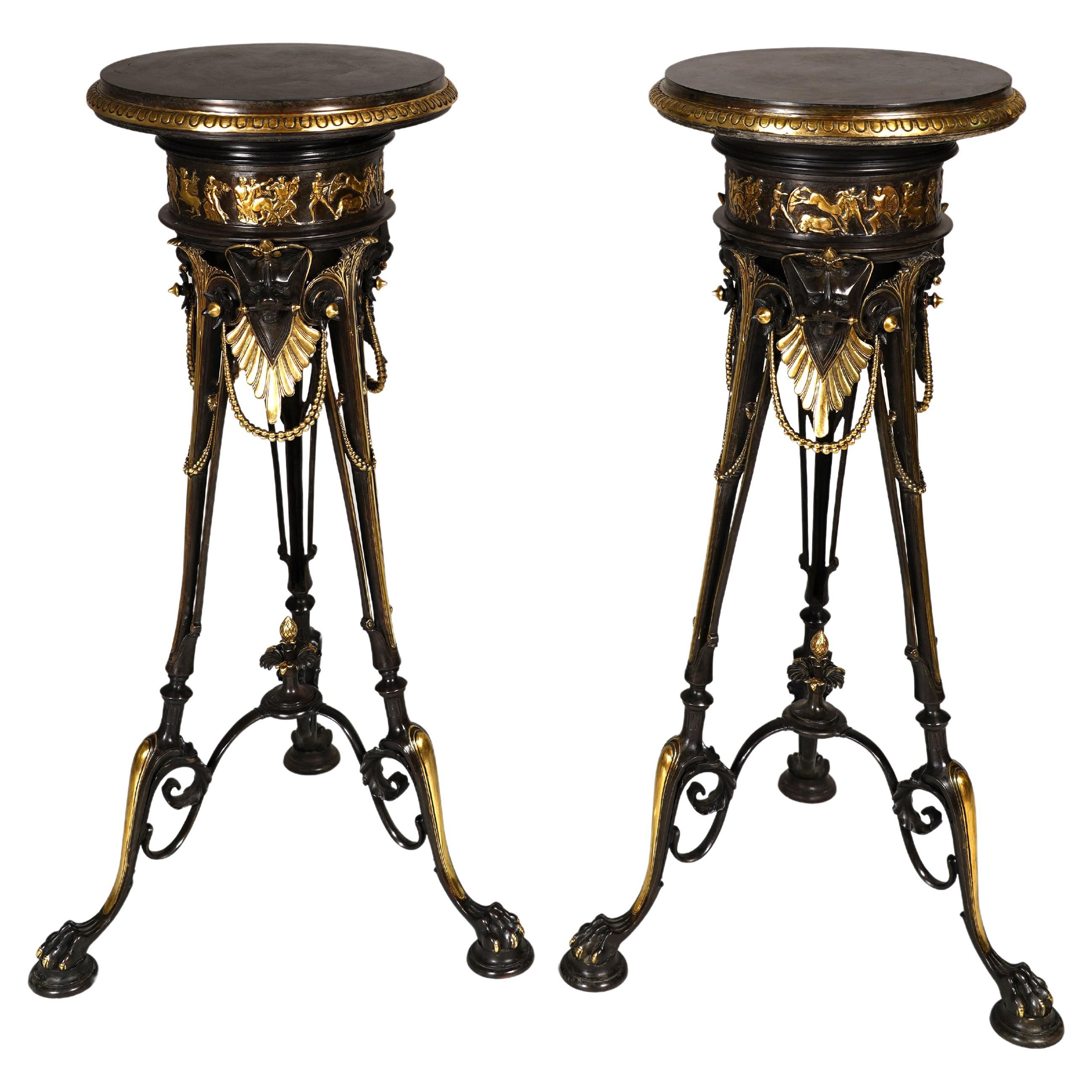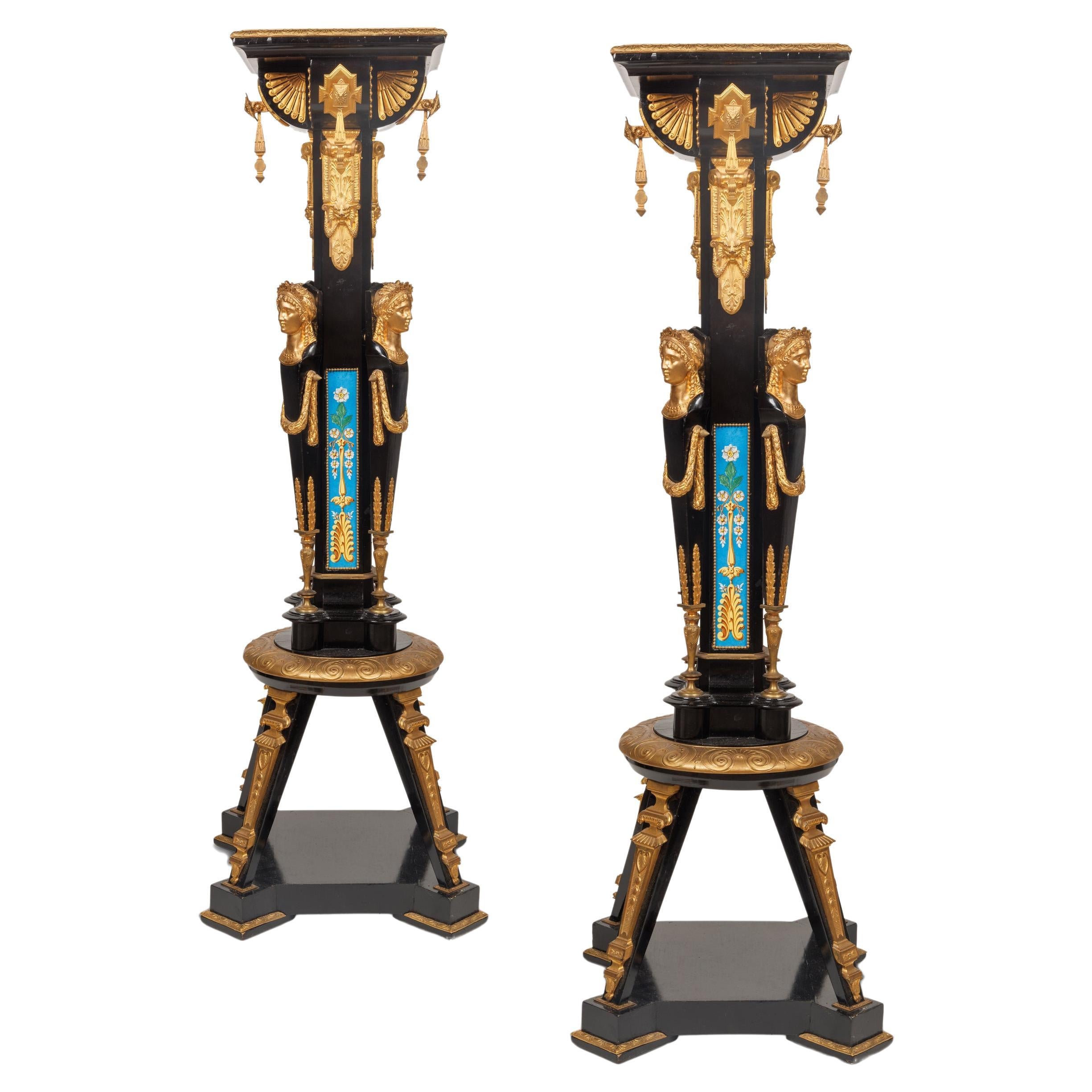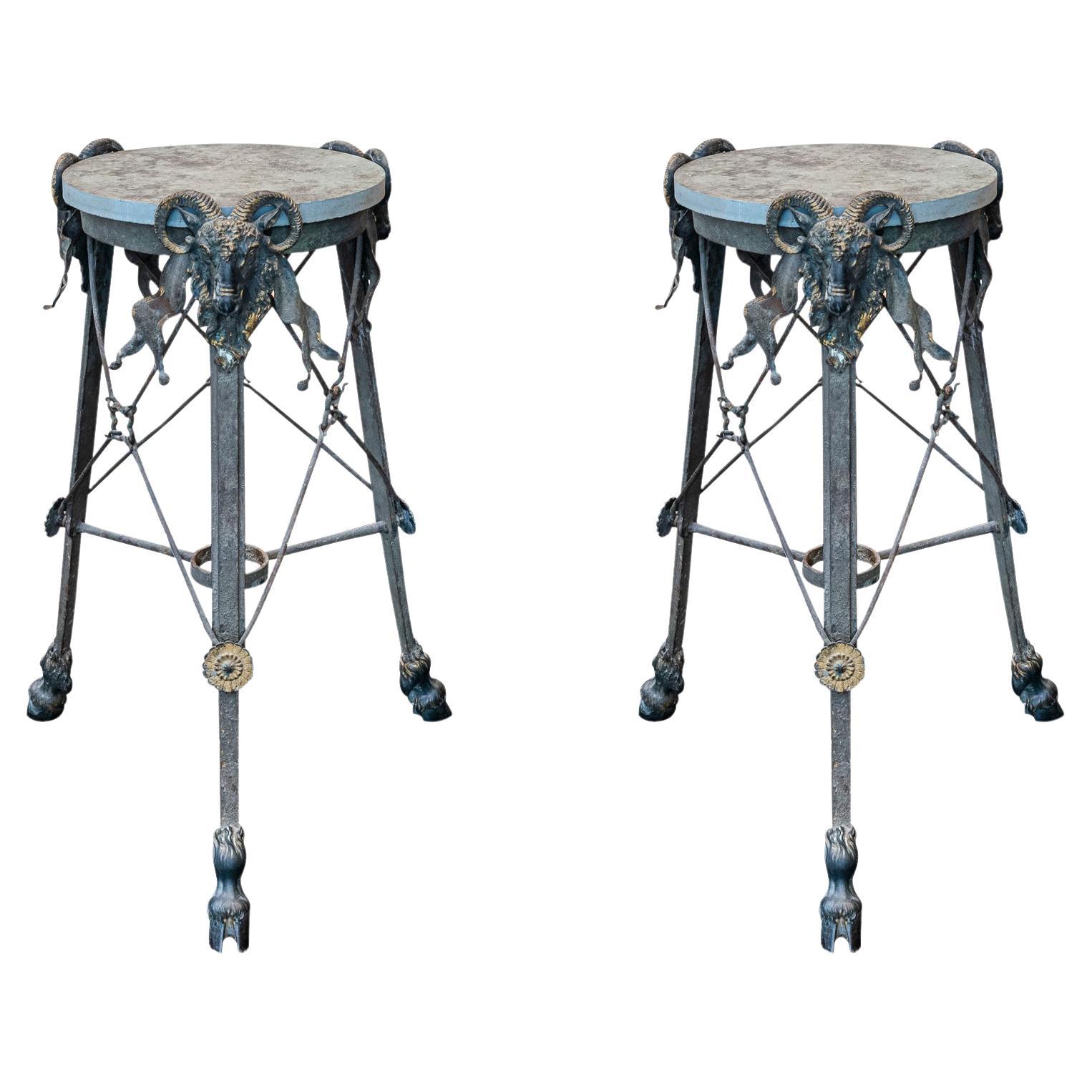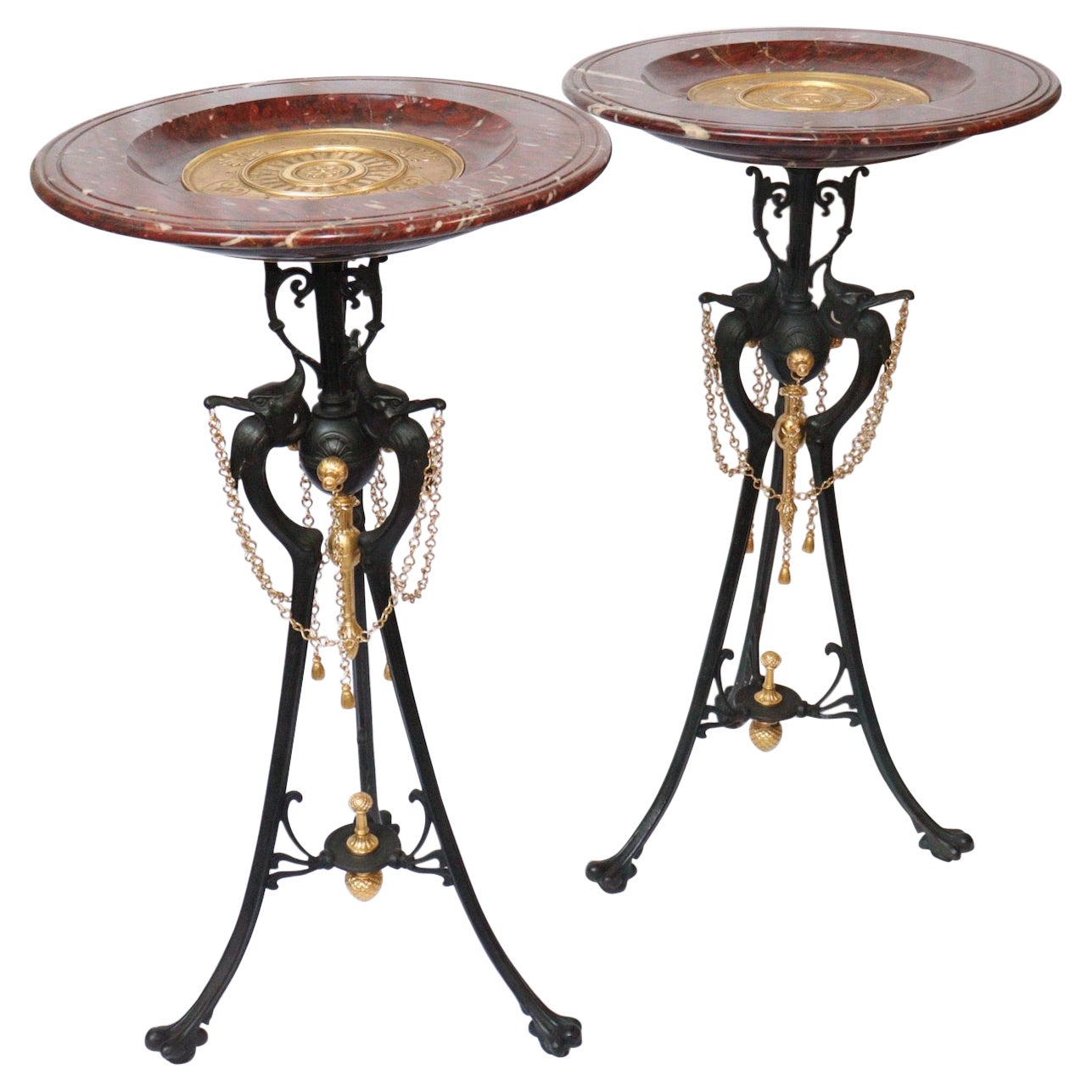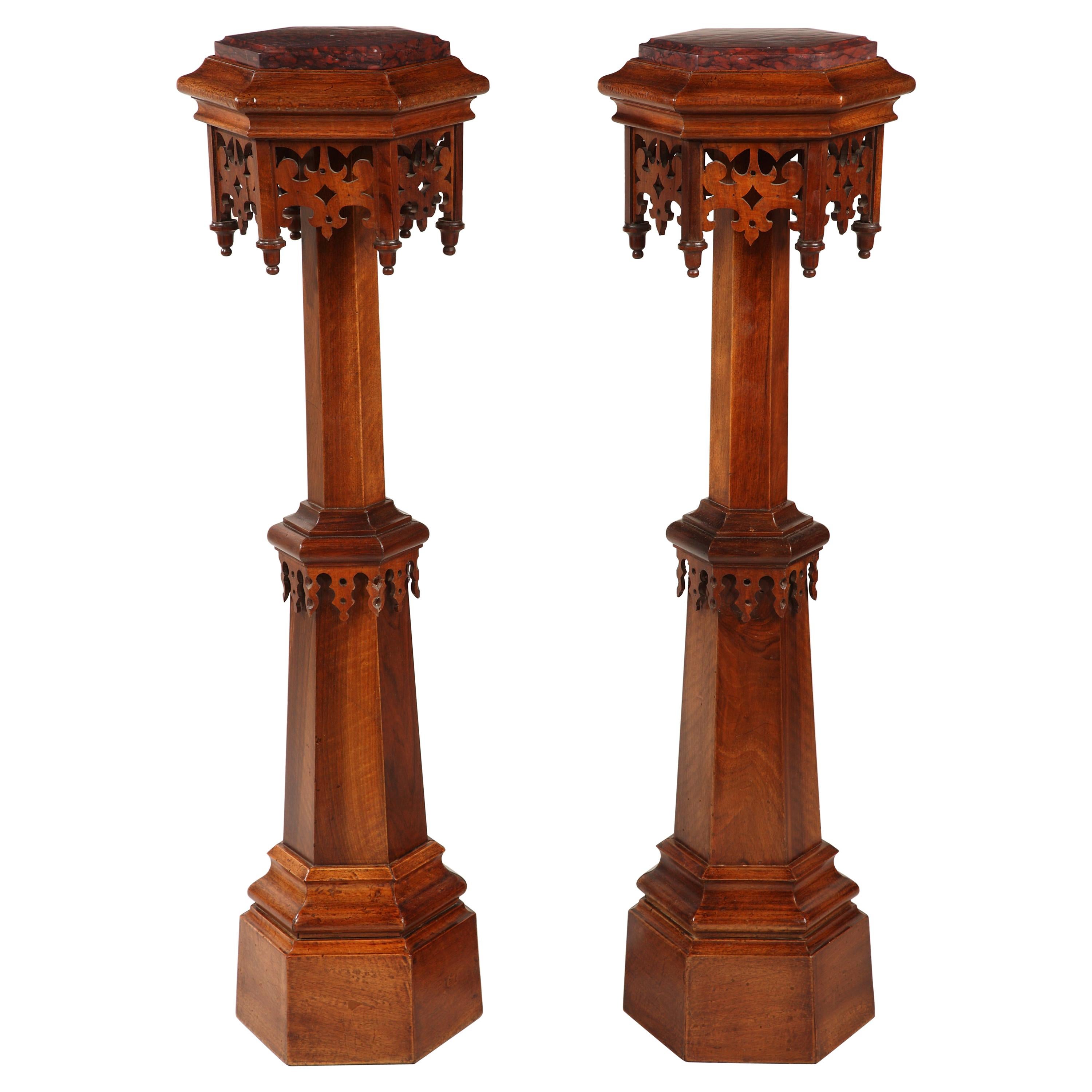Items Similar to Pair of Neo-Greek Pedestals. C.G. Diehl & J.Brandely, France, circa 1867
Want more images or videos?
Request additional images or videos from the seller
1 of 11
Pair of Neo-Greek Pedestals. C.G. Diehl & J.Brandely, France, circa 1867
About the Item
Exceptional pair of neo-Greek style pedestals, made in blackened pearwood, gilded galvanic bronze and glazed earthenware. The sheath-shaped shaft is decorated with rectangular plates in glazed earthenware with floral decoration and palmettes framed by four female busts ending in a detached sheath. It is surmounted by motifs of palmettes, fans and feline heads in bronze supporting a square entablature framed by a frieze. The pedestals rest on a circular base decorated with a bronze frieze of palmettes, supported by four feet resting on a molded base adorned at the corners with friezes of oves.
Related works :
These ornaments are emblematic of the collaboration between the ornemanist J. Brandely and cabinet-maker C.-G. Diehl, and as found on a « table genre grec », a « bahut style grec » or even a « bijoutier de style grec », presented at the Universal Exhibition of 1867 in Paris, where they were commented by the art critic Jules Mesnard in his book : Les Merveilles de l’Exposition Universelle de 1867 : in particular concerning « les anneaux de l’entablement sont ciselés avec amour et l’on remarquera le dessin des pitons qui les portent ; il en est de même du rayonnement en éventail qui meuble la petite console de côté,… la tête d’un beau type grec, et d’une animation sereine, est coiffée d’une rangée de frisons sur le front. Le diadème est d’une finesse d’ornementation qui, si l’on pouvait le détacher, en ferait un véritable bijou » (tome II, p°133 & 149). (see photos attached)
Biography
Arriving in Paris in about 1840, Charles-Guillaume Diehl (1811-1885) founded his cabinet making and decoration firm at 19 rue Michel-le-Comte in 1885. His workshops produced elegant little pieces of furniture in rosewood and thuja and novelties with bronze and porcelain embellishments (see « Les ébénistes du XIXème siècle », D. Ledoux-Lebard, Ed. de l’amateur, 1982, p.164). It was his luxury boxes, however (liqueur cellarettes, cigar cabinets, games boxes, cashmere cases, jewelry cases) which assured Diehl’s renown (see « l’Art en France sous le Second Empire », Exposition Grand-Palais, Paris, 1979, p.133). Already rewarded with a bronze medal at the Universal Exhibition of 1855 in Paris, he exhibited a jardinière with china columns and a liqueur cabinet at the Industrial Arts Exhibition in 1861.
In collaboration with the designer Jean Brandely (active from 1867 until 1873), Diehl renovated his decorative repertory and created astonishing pieces of furniture in the Grecian style which had a dazzling success at the Universal Exhibition in Paris in 1867, where his cabinets also won a silver medal. Certain motifs were so typical of Diehl’s work that they received extensive commentary by the art critic J. Mesnard in his book « Les Merveilles de l’Exposition Universal de 1867 » (vol. II, pp. 133 & 149). He writes of a table of which « the pendant bearing hooks and the fan shaped radiating motif which ornaments the entablature are engraved with love » (p. 133) and a jewelry case where « The head in fine Grecian style makes up the essential part of the fine gilt bronze ornementation » (p. 149).
For this Universal Exhibition Diehl also formed a partnership with two famous sculptors : Emile Guillemin (1841-1907) who carved the relief for a mahogany sideboard with galvanic gilt bronzes (Orsay Museum, Paris, Inv. O.A.O. 992) and Emmanuel Frémiet (1824-1910) who executed the low relief for a cedar medal cabinet with marquetry and silver plated bronzes (Orsay Museum, Paris, Inv. O.A. 10440). Diehl was again rewarded with a medal of honour at the Union Central Exhibition of 1869 and a progress medal at the Universal Exhibition in Vienna in 1873 (Sideboard in blackened pear wood and lemon wood with galvanic bronzes, designed by J. Brandely with a low relief by E. Guillemin, Orsay Museum, Paris, Inv. O.A.O. 336). Showered with praise by the critics, Diehl is considered as one of the most innovating artists of the 19th Century. His final appearance was at the 1878 Universal Exhibition in Paris where he presented outside the competition, his most recent creations, including a work table in marquetry which with its naturalistic grasshopper motif anticipated « Art Nouveau » (Musée de l’Ecole de Nancy, Nancy).
In order to compete with the English production, the Creil (Oise) and Montereau (Seine-et-Marne) manufactures began producing « English style » white paste earthenware as soon as the eighteenth century. At Montereau, English potters refugees in France shared their skills with Louis Leboeuf (1792-1854). Under the Second Empire, technical innovations, added to the enthusiasm of the middle classes in the decorative arts, provided a production of fine standard, more accomplished and more diverse. The white clay was then relayed by the opaque porcelain, then whiter, harder and tougher. With the merger of Manufactures of Montereau and Creil in 1840, Lebeuf went into partnership with Milliet (marks « Lebeuf Milliet and Co. » from 1840 to 1874, followed by « Lebeuf and Co. » from 1875 to 1876). Both partners were constantly seeking to discover new and various techniques and patterns of decoration. This golden age lasted until the early twentieth century as the economic crisis appeared. A restructuring process was started and Montereau was preferred to Creil. The takeover by the Choisy Manufacture in 1920 continued the mass production until 1955, when Montereau definitely closed down its workshops.
- Creator:Lebeuf Milliet & Cie Creil Montereau (Manufacturer),Charles-Guillaume Diehl (Cabinetmaker)
- Attributed to:Jean Brandely (Designer)
- Dimensions:Height: 55.52 in (141 cm)Width: 19.3 in (49 cm)Depth: 19.3 in (49 cm)
- Sold As:Set of 2
- Style:Greek Revival (In the Style Of)
- Materials and Techniques:
- Place of Origin:
- Period:
- Date of Manufacture:circa 1867
- Condition:Wear consistent with age and use.
- Seller Location:PARIS, FR
- Reference Number:
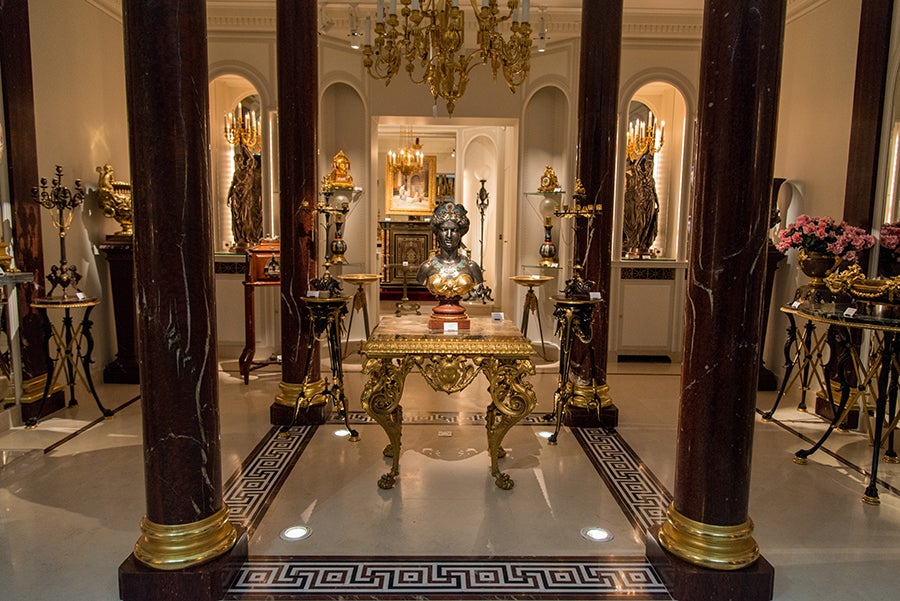
About the Seller
4.9
Vetted Seller
These experienced sellers undergo a comprehensive evaluation by our team of in-house experts.
Established in 1997
1stDibs seller since 2018
73 sales on 1stDibs
Typical response time: <1 hour
Associations
International Confederation of Art and Antique Dealers' Associations
- ShippingRetrieving quote...Ships From: Saint Ouen , France
- Return PolicyA return for this item may be initiated within 7 days of delivery.
More From This SellerView All
- Neo-Greek Cigar Cellarette, C.G. Diehl, E. Frémiet & J. Brandely, Circa 1867By Jean Brandely, Charles-Guillaume Diehl, Emmanuel FremietLocated in PARIS, FRRare cigar humidor made in wood, with a front flap, discovering five sliding cane trays. Beautiful bronze and silver electroplated brass ornaments, such as the central niche decorated with a winged creature, surmounted on top of the cabinet with a feline. Resting on four tall legs joined by a stretcher decorated with a silvered pierced bronze incense burner. The central relief of that cellarette for cigars, with that fantasy creature, is directly inspired from the one designed by J. Brandely for the front door of the Merovingian Cabinet made by Diehl in 1867, and now preserved at the Metropolitan Museum of Art in New York (Inv. 1989.197). Arriving in Paris in about 1840 Charles-Guillaume Diehl (1811-1885) founded his cabinet making and decoration firm at 19 rue Michel-le-Comte in 1885. His workshops produced elegant little pieces of furniture in rosewood and thuja and novelties with bronze and porcelain embellishments (see « Les ébénistes du XIXème siècle »,D. Ledoux-Lebard, Ed. de l’amateur, 1982, p.164). It was his luxury boxes, however (liqueur cellarettes, cigar cabinets, games boxes, cashmere cases, jewelry cases) which assured Diehl’s renown (see « l’Art en France sous le Second Empire », Exposition Grand-Palais, Paris, 1979, p.133). Already rewarded with a bronze medal at the Universal Exhibition of 1855 in Paris, he exhibited a jardinière with china columns and a liqueur cabinet at the Industrial Arts Exhibition in 1861. In collaboration with the designer Jean Brandely (active between 1867 and 1873), Diehl renovated his decorative repertory and created astonishing pieces of furniture in the Grecian style which had a dazzling success at the Universal Exhibition in Paris in 1867, where his cabinets also won a silver medal. Certain motifs were so typical of Diehl’s work that they received extensive commentary by the art critic J. Mesnard in his book « Les Merveilles de l’Exposition Universal de 1867 » (vol. II, pp. 133 & 149). He writes of a table of which « the pendant bearing hooks and the fan shaped radiating motif which ornaments the entablature are engraved with love » (p. 133) and a jewelry case where « The head in fine Grecian style makes up the essential part of the fine gilt bronze ornementation » (p. 149). For this Universal Exhibition of 1867, Diehl also formed a partnership with two famous sculptors : Emile Guillemin (1841-1907) who carved the relief for a mahogany sideboard with galvanic gilt bronzes (Orsay Museum, Paris, Inv. O.A.O. 992) and Emmanuel Frémiet (1824-1910) who executed the low relief for a cedar medal cabinet...Category
Antique 1860s French Greek Revival Tobacco Accessories
MaterialsBrass, Bronze
- Neo-Greek Inkwell by C.G. Diehl, E. Frémiet and J. Brandely, France, Circa 1867By Jean Brandely, Charles-Guillaume Diehl, Emmanuel FremietLocated in PARIS, FRSigned Diehl à Paris. Wood and silvered copper inkwell. Central drawer ornamented with an escutcheon and flanked by two small lateral drawers forming two containers, surmounted by a lid representing a nestling. Central niche ornamented with a winged creature. Inkwell flanked by two felines. Toped by a penholder representing a Moorish head resting on an eagle claw. This exceptional piece was realized thanks to the collaboration of ornemanist J. Brandely, sculptor E. Frémiet and cabinet-maker C.-G. Diehl. The motif of the fantasy creature dear to Diehl, is to be seen on the famous cabinet made by him in 1867 and now exhibited at the Metropolitan Museum of Art in New York (Inv. 1989.197). Arriving in Paris in about 1840 Charles-Guillaume Diehl (1811-1885) founded his cabinet making and decoration firm at 19 rue Michel-le-Comte in 1885. His workshops produced elegant little pieces of furniture in rosewood and thuja and novelties with bronze and porcelain embellishments (see “Les ébénistes du XIXème siècle”, D. Ledoux-Lebard, Ed. de l’amateur, 1982, p.164). It was his luxury boxes, however (liqueur cellarettes, cigar cabinets, games boxes, cashmere cases, jewelry cases) which assured Diehl’s renown (see “l’Art en France sous le Second Empire”, Exposition Grand-Palais, Paris, 1979, p.133). Already rewarded with a bronze medal at the Universal Exhibition of 1855 in Paris, he exhibited a jardinière with china columns and a liqueur cabinet at the Industrial Arts Exhibition in 1861. In collaboration with the designer Jean Brandely (active from 1867 until 1873), Diehl renovated his decorative repertory and created astonishing pieces of furniture in the Grecian style which had a dazzling success at the Universal Exhibition in Paris in 1867, where his cabinets also won a silver medal. Certain motifs were so typical of Diehl’s work that they received extensive commentary by the art critic J. Mesnard in his book “Les Merveilles de l’Exposition Universal de 1867” (vol. II, pp. 133 & 149). He writes of a table of which “the pendant bearing hooks and the fan shaped radiating motif which ornaments the entablature are engraved with love” (p. 133) and a jewelry case where “The head in fine Grecian style makes up the essential part of the fine gilt bronze ornamentation” (p. 149). For this Universal Exhibition Diehl also formed a partnership with two famous sculptors: Emile Guillemin (1841-1907) who carved the relief for a mahogany sideboard with galvanic gilt bronzes (Orsay Museum, Paris, Inv. O.A.O. 992) and Emmanuel Frémiet (1824-1910) who executed the low relief for a cedar medal cabinet...Category
Antique 1860s French Greek Revival Inkwells
MaterialsCopper
- Pair of Neo-Greek Pedestals, attributed to G.Servant, France, Circa 1880By Georges Emile Henri ServantLocated in PARIS, FRPair of patinated and gilded bronze turntable pedestals with for each of them, three paw feet, headed by stylized lion muzzles, ornated with beaded chains and joined by a fine foliate stretcher. The belt is adorned by a banded frieze cast in low-relief representing an ancient scene : “The Battle of the Lapithes and the Centaurs”. These pedestals can be associated with the "Vases de Bacchus", presented by G. Servant at the 1867 Exposition Universelle, on which the similar ornamentation is applied. (Reproduced in « Merveilles de l'Exposition Universelle de 1867 », Jules Mesnard, p°167) Biography : Georges Emile Henri Servant...Category
Antique 1880s French Greek Revival Pedestals
MaterialsBronze
- Lovely Neo-Greek Planter Attributed to C-G Diehl, France, Circa 1870By Charles-Guillaume DiehlLocated in PARIS, FRCircular plant pot with a double tray united by a black tripod attributed to C-G Diehl. Charming wood marquetry. A beautiful gilded bronze adornment complete this piece. Arriving in...Category
Antique 1870s French Greek Revival Planters and Jardinieres
MaterialsBronze
- Pair of Neo-Gothic Stands, France, Circa 1880Located in PARIS, FRA very fine pair of Gothic Revival natural wood stands. Each composed of a hexagonal molded red Griotte marble top, resting on a hexagonal tapering shaft. Adorned all-over with carve...Category
Antique 1880s French Gothic Revival Pedestals
MaterialsGriotte Marble
- Fine Neo-Greek Clock Set by H. Houdebine, France, Circa 1867By Henri HoudebineLocated in PARIS, FRDial signed H. Houdebine, Fabricant de Bronzes, Rue de Turenne 64, Paris and clockwork signed Japy Frères & Cie – Médaille d’Honneur A very fine neo-Greek style clock set made up of...Category
Antique 1860s French Greek Revival Table Clocks and Desk Clocks
MaterialsBronze
You May Also Like
- Charles-Guillame Diehl and Jean Brandely Museum Quality Neo-Grec Torchères, 1870By Charles-Guillaume DiehlLocated in New York, NYA highly important pair of Charles-Guillame Diehl and Jean Brandely Museum Quality Ormolu and Porcelain Mounted Ebony Neo-Grec Torchères / Pedestals circa 1870. Majestic and exemp...Category
Antique Late 19th Century French Napoleon III Pedestals
MaterialsOrmolu
- Pair of Neo-Antique Pedestals, France, circa 1880Located in Nice, Cote d' AzurPair of Neo-Antique Pedestals, Decorated with bronze bull heads and animals hoof, Iron with Antique patina, Green marble tabletop, France, circa 1...Category
Antique 1880s French Mid-Century Modern Pedestals
MaterialsMarble, Bronze, Iron
- 19th Century Pair of Neo Greek Sellettes en AthéniennesBy Ferdinand BarbedienneLocated in Saint-Ouen, FRA French 19th century very unusual and decorative pair of neo greek gilt and patinated cast iron sellettes en athéniennes With red griotte marble bassin...Category
Antique 1870s French Greek Revival Pedestals
MaterialsGriotte Marble, Metal, Ormolu
- Pair of American 1940s Neo-Classical PedestalsBy McMillenLocated in New York, NYThis pair of walnut-veneered, black marble and brass neoclassical pedestals bear a striking resemblance to those that appeared in the rooms decorated in by Eleanor Brown of McMillen ...Category
Vintage 1940s American Biedermeier Pedestals
MaterialsMarble, Brass
- Italian Neo-Classic PedestalsLocated in New York, NY2 Pair of Italian Neo-classic (19th Cent) pedestals with a steel and brass cross arrow design that supports a round white marble top. (PRICED PER Pair)Category
Antique 19th Century Italian Neoclassical Pedestals
MaterialsMarble, Brass, Steel
- Pair of French Louis XV PedestalsLocated in New York, NYPair of French Louis XV style (19th Cent) pedestals with Asian Chinese style celadon porcelain and bronze dore festoon trim and base with claw ...Category
Antique 19th Century French Louis XV Pedestals
MaterialsBronze
